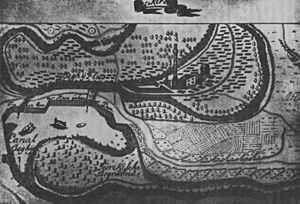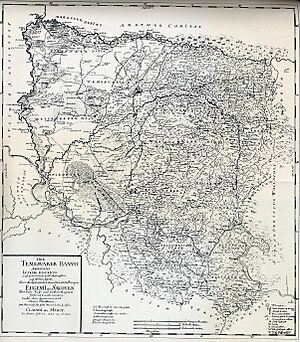Nova Barcelona facts for kids
Nova Barcelona (also called New Barcelona) was a special settlement that existed for a short time, from 1735 to 1738. It was a colony for Catalan people who were forced to leave their homes. These people were called Austracists, meaning they supported the Habsburg family during a big war.
The colony was in a place called the Banat of Temeswar. This area is now near the city of Zrenjanin in Vojvodina, Serbia. Sometimes, the colony was also known as Carlobagen.
Contents
A New Home in the Banat
In October 1716, a big battle happened near Petrovaradin. The Habsburgs, a powerful European family, won against the Ottoman Empire. This victory helped them take control of a town called Bečkerek (now Zrenjanin).
Later, in 1718, a peace treaty was signed. The Ottoman Empire gave the Banat of Temeswar region to the Austrian Habsburgs. This new land needed to be developed. So, in 1719, a company was started to help with trade. It aimed to boost business with the Ottoman Empire using rivers and ports.
The Banat region didn't have many people living there. The Habsburg rulers wanted to bring in new settlers to help the area grow.
Austracists: A Second Journey
After the Habsburgs lost control of Spain and Naples in the early 1700s, many people who were loyal to them had to leave. Most of these loyalists, called Austracists, settled in cities like Vienna and Buda. They received money and support from the Austrian government.
However, the Austrian authorities weren't happy with how many immigrants there were. They decided to move some of them to the Banat, specifically to the town of Pančevo. The authorities felt these settlers were not contributing much. They wanted to encourage them to work and become useful.
The Emperor Charles VI wanted to turn these refugees into new settlers. He planned to create a new settlement for them. This new place was supposed to be called Nova Barcelona (New Barcelona). Other names like Carlobagen or Carolina were also suggested.
Settlers Arrive
The first group of exiles arrived in the autumn of 1735. By 1737, there were about 800 exiles in the Banat region. Many of them were from Catalonia, and others came from different parts of the Crown of Aragon. About 10% to 15% were from Sicily and Naples.
Some important people from the War of the Spanish Succession were among these exiles. They included brothers Rafael and Joan Nebot, and Captain Francesc de Castellví i Obando.
The decision to move them was made in November 1736. Each man was given 5 forints, women 2, and children 0.5 forints to help them settle. The Banat administration was told to find jobs for them. This way, the money spent on them could be paid back. The Catalans, often called Spaniards by the local people, also received yearly help. All their old debts were canceled.
Josef Huber, who was in charge of the move, reported on the settlers. He noted that many didn't have specific jobs. He also observed that the women were often good at knitting and weaving.
The settlers first arrived in Pančevo. From there, they were sent to other places like Timișoara and Vršac. A specific spot was chosen for the new settlement, just south of Bečkerek (modern Zrenjanin). It was planned to be a Spanish town. An Italian traveler, Francesco Griselini, mentioned it as New Barcelona. A map from 1740 also shows "Neue Stadt Barcellona."
An engineer named Captain Kaiser drew up a plan for the town. It included houses, fields, gardens, and vineyards. Building materials were sent from Austria. Skilled workers from Vršac were called in, and construction was set to begin in October 1737.
Why the Colony Failed
However, the construction of Nova Barcelona never really started. The project failed for several reasons.
First, a war broke out between the Austrians and the Ottomans in 1737. The threat of war nearby made it a bad time for a new settlement. Also, many of the settlers were older, and some were former soldiers or administrators. The climate in the Banat was also very different from their homes. This made it hard for them to adjust and affected their health.
The biggest reason for the failure was the outbreak of the Great Plague of 1738. This terrible disease spread through the region. Many people, including some of the Catalan and Italian settlers, died.
Less than a year after the settlement was planned, the authorities allowed the remaining settlers to move back to Vienna and Buda. By 1740, many exiles had left. German colonists, who were fleeing another war, moved into the 30 houses that had been finished.
In October 1740, Emperor Charles VI died. His daughter, Maria Theresa, became the new ruler. She was not bound by the same promises to the Austracist refugees. By this time, most of the exiles had already moved to cities in Austria-Hungary, like Buda, Pest, and Vienna. The few Catalans who remained eventually blended in with the German or Hungarian populations.
Legacy
Even though the Austracist colony didn't last, there is a small connection to the region. Francesc Vilana Perlas i Fàbrega, whose father was a Catalan émigré, became the governor of Temeswar from 1753 to 1759. Some believe that the name of the village Perlez, near Zrenjanin, might come from his family name.
See also
 In Spanish: Nueva Barcelona para niños
In Spanish: Nueva Barcelona para niños



